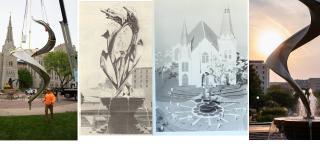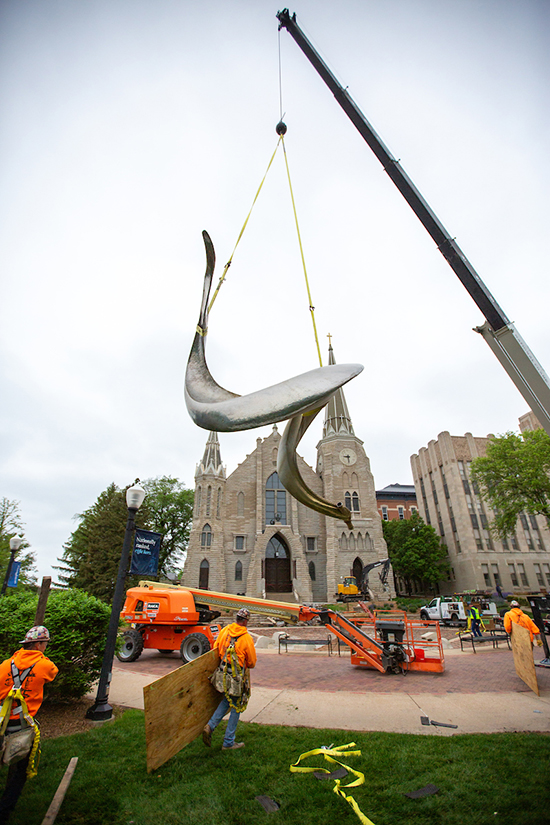
Growth spurts and false starts
It’s shaping up to be quite the constructive summer at Creighton’s Omaha campus. Not only is the University putting the final touches on a new health sciences building, new residence hall (both opening in August) and new Jesuit residence (opening this coming academic year). It’s also upgrading the St. John’s Plaza and Fountain.
Recently, the Eternal Flame sculpture took flight, lifted by a crane from the spot where it’s stood for nearly 30 years. Don’t worry, the flame will return to the top of a new fountain this summer. (You can read more about the renovations here.)
With all the changes taking shape and with it being the 30-year anniversary of the flame, we thought now would be as good a time as any to celebrate one of the most — if not the most — iconic and beloved spots at Creighton.
Here’s the history of the fountain, the flame, the Mall and the many false starts Creighton took down the ruddy brick road to the heart of campus — from a planned ice-skating rink in front of Gallagher to a controversial nude sculpture doomed to wander from hall to hall after its fall from the fountain.
You can also check out the fountain photo gallery or listen to the Weird Creighton History podcast.

1914: Creighton’s first fountain
The senior class of what was then the “College of Arts” made a gift to build a large stone memorial fountain on the college lawn to the east of Creighton Hall (previously known as the Administration Building and before that simply, “the main building”). The fountain’s design included a base with four small lion heads.
The arts Class of 1914 (just 19 students) presented the fountain to the University during the commencement ceremony. The College of Arts dean gave quite a speech expressing his gratitude. The speech is long, but it’s just too amusingly and metaphorically about fountains not to include it in a story about fountains. Read the full speech here.
(Note: I couldn’t find any records that indicate when Creighton’s first fountain was removed, but it was there at least through the 1930s.)
1930: The Rigge waterfall and pond
Father William Rigge, SJ, Creighton professor, world-renowned astronomer and mathematician, died in 1927, nearly 50 years after he started as one of the University’s first faculty members.
A few years later, Creighton built a memorial waterfall and pond next to the Observatory, from which Rigge spent countless hours gazing up at the heavens. You can read (and hear) more about the amazing Fr. Rigge here.
Photos and illustrations of the pond and shrine ...
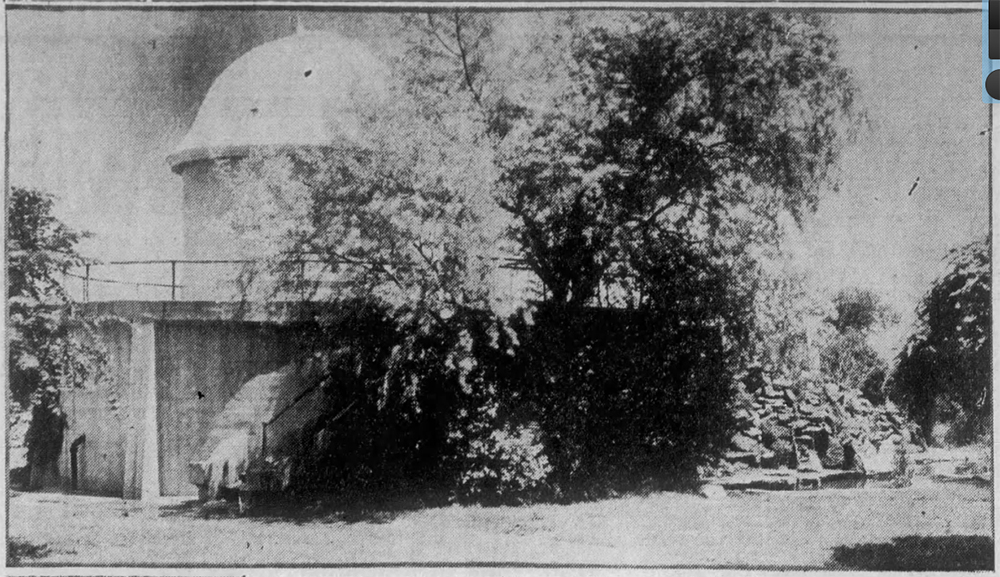

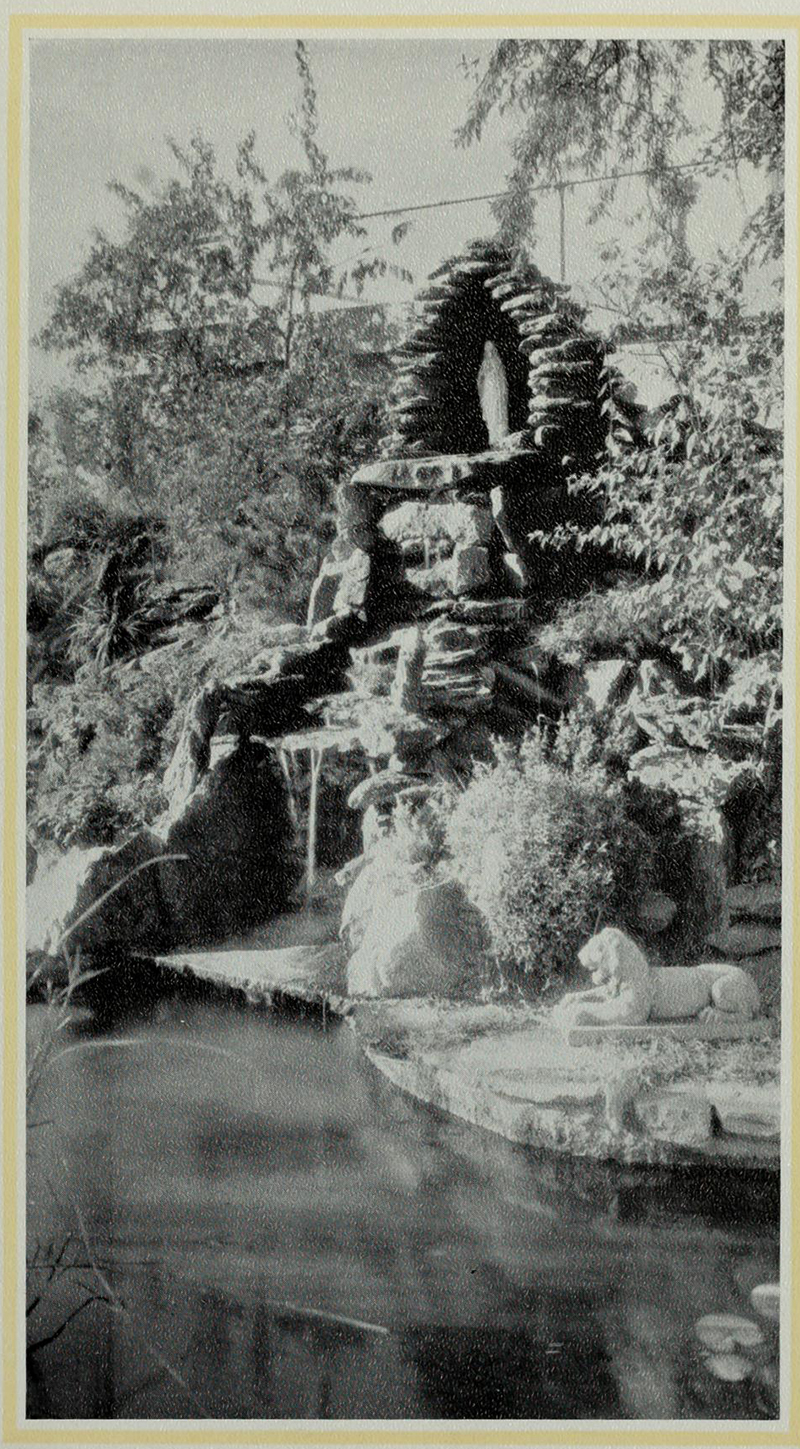
We even have video (from the 1930s) of the waterfall, pond and the Jesuit Gardens, courtesy of Tony Schenk, BSPHA'68, and Tony’s late father, Leonard Schenk, BSPHA'39.
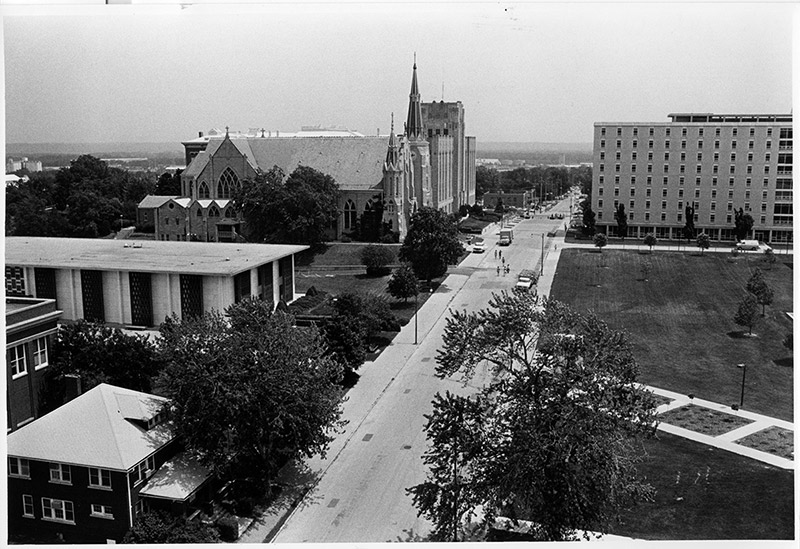
1955: No more streetcars
Omaha scrapped its streetcar system that year in favor of buses. Somewhere around that time, asphalt was poured over California Street, covering the bricks and the streetcar track that ran through campus.
(An abridged history of the Omaha-Council Bluffs streetcar system: It started in 1868, a decade before Creighton opened its doors. By 1890, the metro area had about 90 miles of track, more than any city but Boston, according to the Omaha World-Herald. The streetcar company was continually met with labor disputes. The strike of 1935 grew so violent that the Nebraska governor called in the National Guard and declared martial law in Omaha.)
* * *
See images of the fountain and the sculpture over the years.
* * *
1976-77: Plans for the Mall
Creighton closed California Street to vehicle traffic through campus and announced plans for the campus Mall. The original design included not only the plaza and fountain in front of St. John’s Church but — on the west end of campus near where Gallagher Hall used to be — a pond crossed by a pedestrian bridge. The pond was intended to serve as an ice-skating rink during the winter. The idea was eventually scrapped due to its expense.
(I couldn’t determine exactly when Creighton removed the asphalt on California Street — or, at least, the section stretching from Gallagher Hall to 24th Street — but alumni who went to school around this time will recall the re-revealed red bricks and shiny rails.)
Here are some renderings of what the Mall, fountain and plaza were originally supposed to look like ...



1978: St. John’s Fountain
The summer of Creighton’s centennial, work began for the 90-foot-wide fountain and plaza in front of St. John’s Church. The Leo A. Daly Co.-designed fountain was actually a birthday gift from Omaha union laborers, a token of gratitude for all the work Creighton’s continual construction had provided. From 1956 to 1978, Creighton had built 19 buildings costing a total of more than $130 million.
The gift of the plaza and fountain cost the labor union members about $150,000 in labor, equipment, cement and bricks (thousands of the bricks reclaimed from California Street). That summer, more than 300 Omaha volunteers from labor unions, construction trade associations and contractors worked nights and weekends to build the fountain and plaza.
The project was a family affair, with the children of laborers participating in the groundbreaking ceremony. “We had children breaking the ground,” one worker said, “because what we are donating to the University and to the community is not for ourselves but for future generations.”
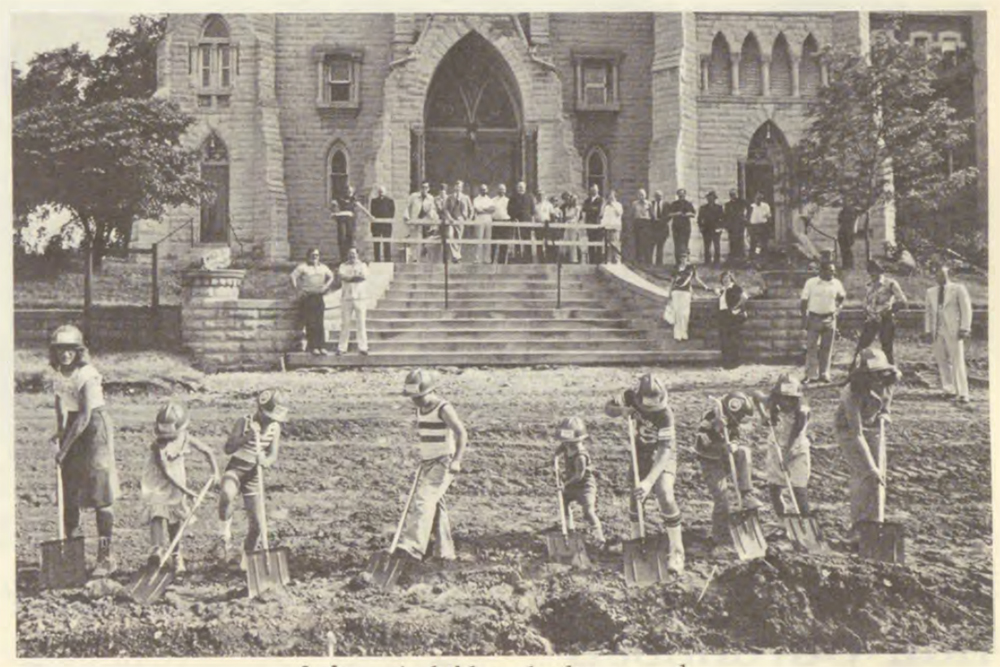
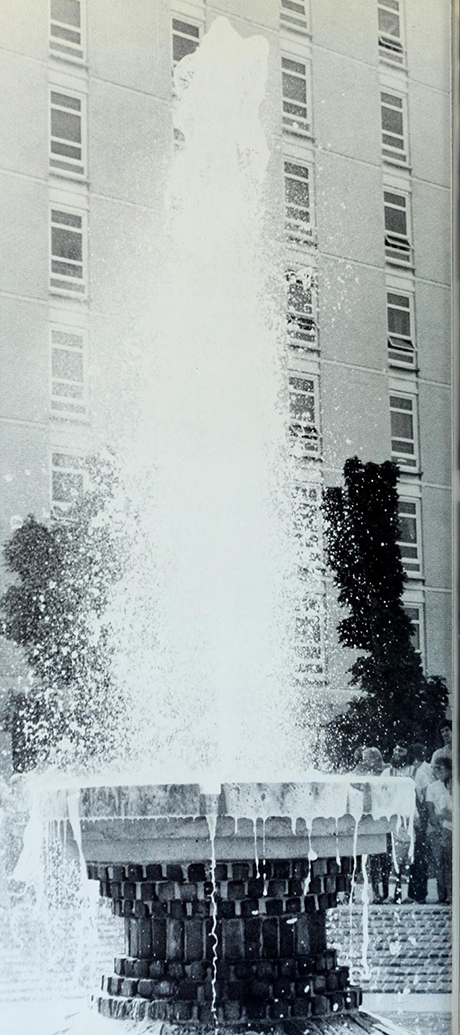
Creighton, in turn, offered the workers and their families access to the Kiewit Fitness Center. The University also awarded an honorary degree to the man who spearheaded the project, Terry Moore, president of the Omaha Central Labor Union and a member of Creighton's President’s Council.
(One cool thing to note: some of the labor union workers who helped build the fountain and plaza in 1978 recently reached out to Creighton when they heard about the renovations. Creighton Facilities Management supplied them with a few keepsakes of their 45-year-old construction.)
Workers completed the fountain in time for its Labor Day dedication. From the Creightonian’s coverage:
“The 90-foot brick piazza slopes gently towards a pedestal containing a geyser spouting water 15 feet into the air as water flows from seven stylized gargoyles around the centerpiece. At night, underground lighting illuminates the water The nature of the fountain is open, inviting people to touch or walk through the running water — or to just sit and enjoy.
“The fountain, however, is not yet complete. The pedestal is also designed to hold a sculpture that will become an integral part of the piazza. A nationwide search has begun for a professional artist who will be commissioned to build a sculpture designed along the theme, ‘The Jesuit Spirit in Education.’”
(It would take another 15 years for the fountain to get its sculpture.)
Christmas 1978: The tree
With the holiday season approaching and Creighton still searching for a sculpture, the fountain served as the makeshift stand of a Christmas tree. Many of the same Omaha laborers who built the St. John’s plaza the previous summer donated their time to fasten to the fountain a 20-foot tree donated by a Council Bluffs nursery.
This was the start of the Christmas at Creighton lighting celebration that continues today. The University put a Christmas tree on top of the fountain for many years after, drumming up the students’ holiday spirit while also, inadvertently, planting the seeds for a Creighton controversy. (It wouldn’t reach full growth for another 20 years.)
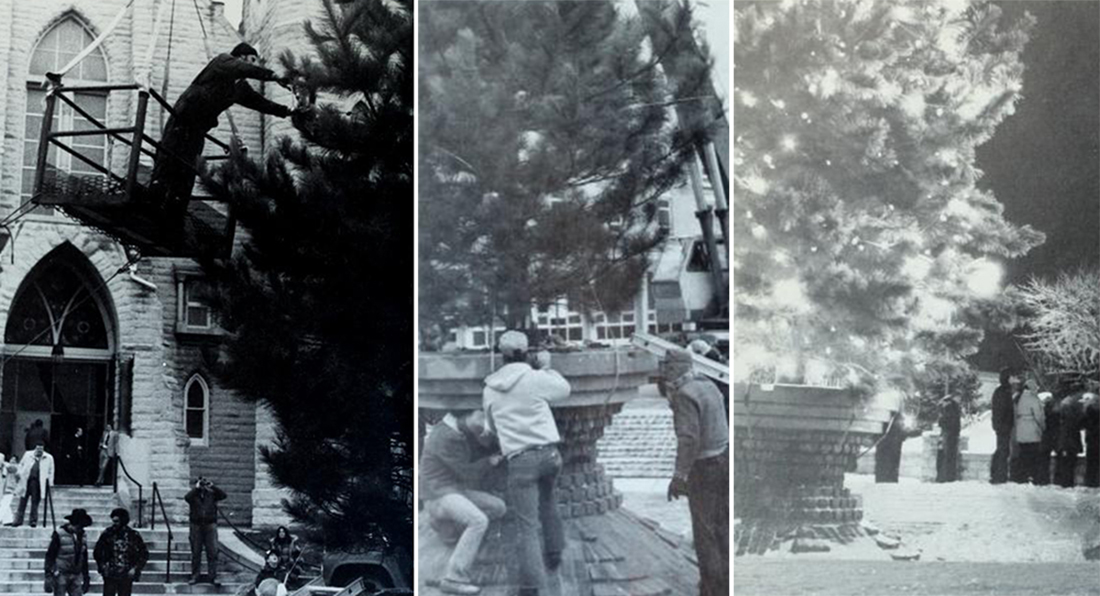
1979-ish: Tallest of the Mall
Creighton later decided that the fountain should serve as the Mall’s highest point. To achieve this, five feet of ground was leveled off in front of Creighton Hall, making the fountain the tallest of the Mall.
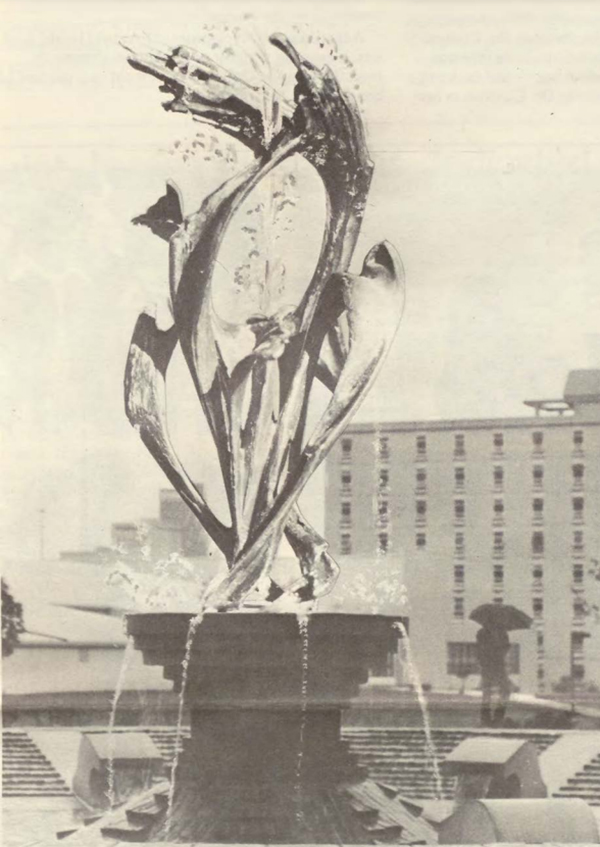
1979: The fountain sculpture, part 1 of 3
A year after the plaza was built, the Creightonian reported that the University had commissioned artist Robert Cook to make a sculpture for the fountain. Cook was reportedly the winner of a contest in which more than 70 artists submitted their designs.
Cook’s sculpture was an abstract design suggesting tree branches lifting skyward (a tree of knowledge embodying the “Jesuit Spirit in Higher Education”). Cook’s planned work would stand 14 feet above the already complete pedestal. It would be cast in bronze and made in Rome.
As you might have gathered, the tree of knowledge sculpture never took root. I couldn’t find any record of why this original project fell through. Possibly a lack of funding. It was later reported that a University committee rejected all the submitted designs, with no mention of Cook’s.

1980 — The Mall
The Mall was completed, or at least the portion of it between the new Deglman Circle to the fountain. Around the same time, Creighton Hall also got a new walkway and benches.
In the Mall’s early years, efforts to make campus look more like a campus were reportedly slow and arduous. Planting a lot of trees and bushes helped. In any case, for more than 40 years now, the Mall has served as Creighton’s circulatory system.
1982 — The Skinner Mall
The University named the central campus Mall in honor of Lloyd E. and Kathryn G. Skinner, longtime Creighton supporters and owners of the Skinner Macaroni Company. Lloyd had graduated Creighton with a Bachelor of Arts degree in 1936.
“This tribute is fitting,” then-Creighton President the Rev. Michael G. Morrison, SJ, said at the time, “because the Mall is where the Skinners’ extended family at the University spends a great deal of time. I make a point of being on the Mall as much as I can to be with and talk to students.”
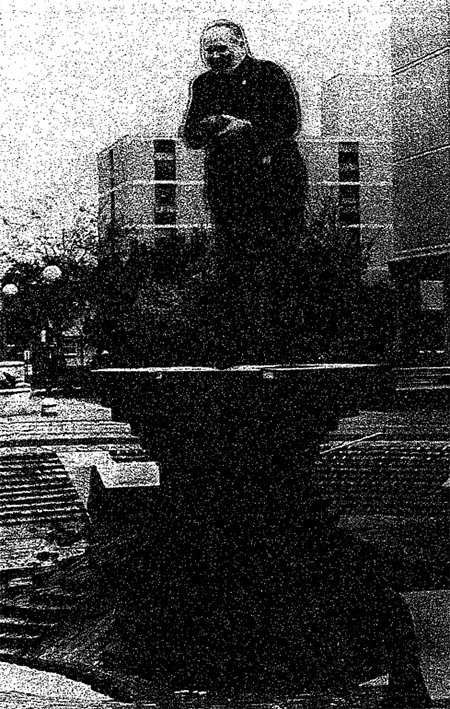
1983 — Student suggestions
With the fountain sculpture still in limbo, the students of the Rev. Michael J. Flecky’s, SJ, photography class were tasked with an assignment to “complete” the fountain. Their proposed sculpture designs included a Rubik’s Cube and Fr. Morrison running a touchdown.
1985-1987: The fountain sculpture, part 2 of 3
Most people think that the first sculpture to sit on top of the St. John’s Fountain was none other than the Eternal Flame. But there was an earlier sculpture — the “Suscipe” a 12-foot bronze abstraction of a male figure that took Creighton artist-in-residence the Rev. Jonathon Haschka, SJ, six years to complete.
No one questioned the artistic merit of the sculpture. But the fact that it was nude? That was an issue for some people.
(Note: The writer thought it might be juvenile to include an uncensored image of the sculpture in the article, which is exactly why he wanted to do so. But as a pre-emptive courtesy to his esteemed editor, he chose not to, instead linking to a series of articles outlining the whole Suscipe saga.)
(Editor’s note: Thank you.)
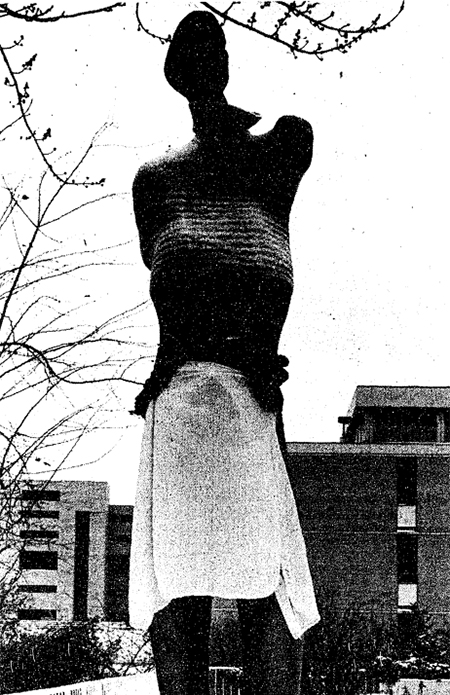
The Suscipe sculpture — named for a Latin word that translates to “Take, oh Lord” and opens a prayer from the fourth week of the Ignatian exercises — was installed on top of the St. John’s Fountain in the summer of 1985. Controversy ensued, and it was removed within a week.
University officials said that Suscipe’s stay on the fountain was always intended only to be temporary, but Haschka — who passed away in 2019 — maintained that he made the sculpture specifically for the fountain, designing it in proportion to St. John’s Church.
Suscipe’s next few years were a real journey. After its removal from the fountain, it went to the lawn of the Reinert Alumni Memorial Library, then to an area south of the Eppley Building (where students covered its lower half with a blanket). Fresh complaints kept sending it to different locations. The south side of the Rigge Science Building, the Fine Arts Building, back to the library, then back to the Eppley Building. Eventually, it disappeared from campus altogether, apparently put into storage.
“I’m pretty much depressed with the whole situation,” Haschka told the Creightonian in 1987, after the sculpture had moved to its fifth location in two years.
At the time, a Creighton philosophy professor wrote an article defending Suscipe in the faculty magazine Colleague. He wrote:
“The odyssey and now banishment of Suscipe has never been defended on the grounds of artistic inferiority, but simply because the figure is too explicit. The problem is that the androgynous statue has no clothes. This gives some people a nervous twitch.”
All of this is to say … the fountain still needed its sculpture.
(UPDATE: We found Suscipe! He was hiding in plain sight the whole time. My trusty colleague Casey Hoag, Creighton's senior director of external relations, found the sculpture hanging out between the Hitchcock and Eppley buildings. It's still a beautiful sculpture, and it would still probably spark a minor controversy if they tried to put it on top of the St. John's Fountain today. In any case, we're happy to see that Suscipe found a permanent home and, one hopes, some semblance of peace after such a tumultuous journey.)

1989: The fountain sculpture, part 3
Creighton commissioned artist Grant Kenner of Canton, Missouri, to make a 15-foot stainless-steel sculpture for the St. John’s Fountain — the “Eternal Flame.” The sculpture was funded by a gift from John Micek, BS’50, and Anna Lou Micek, BA’75, of Omaha.
Creighton fine arts instructor Mary Beth Fogarty had discovered a model of Kenner’s sculpture at a symposium and thought it would be perfect for the fountain.
“I like the kinetic feeling to his work,” Fogarty said. “The sculpture emphasizes the importance of movement with its rotation and the water moving up and through the piece.”
The Rev. Don Doll, SJ, fine arts and photojournalism professor, said at the time that no previous proposals had embodied the essence of a Jesuit education. But this time Creighton had found the right sculpture to represent that ideal. “The flame shape,” Doll said, “can be interpreted as a symbol of eternal knowledge.”
And finally, Creighton President the Rev. Michael Morrison, SJ, approved the Eternal Flame on the condition it would be enlarged from 6 feet tall to 15 feet, making it more proportional to the fountain.
The sculpture was set to be completed and installed by the spring of 1990.
1993: At long last, the Eternal Flame arrived. The St. John’s Fountain was complete.

In the original design, a motor made the sculpture rotate atop its brick stand, but the one Creighton purchased proved insufficiently powerful to move the 700-pound sculpture. Plans to obtain a more powerful motor never came to fruition, and the flame remained stationary.
Christmas 1993: A permanent tree
As a reminder, every year since the fountain first came to Creighton in 1978, it had served as a stand for the campus Christmas tree. With the “Eternal Flame” sculpture now taking its spot, the Christmas tree was moved to the front of Creighton Hall. That same year, 1993, a permanent Christmas tree — a tall spruce courtesy of Mulhall Nursery and other donors — was placed near the fountain and lit up in time for the holiday season.
For seven years, the two Creighton Christmas trees — the permanent one and the one in front of Creighton Hall — coexisted peacefully.
2000: A Christmas controversy
New Creighton President Fr. John P. Schlegel, SJ, asked a fair question … Why are we cutting down a new tree every year when there’s a perfectly good one planted nearby?
Fr. Schlegel said they would scrap the tradition of a tree in front of Creighton Hall and use the already planted spruce as the sole campus Christmas tree.
Students had feelings.
More than 630 of them signed a petition protesting the removal of the Creighton Hall tree.
Fr. Schlegel, for his part, was both apologetic and amused by the students’ reaction. In a Creightonian interview, he jokingly referred to himself as “the Grinch who stole your Christmas tree.”
Of course, in the end it was fine. The Creighton Christmas tradition continues today.

2006: Upgrades
Creighton installed a new brick ring and benches around the fountain.
May 2023: Removal of the Eternal Flame
Creighton recently plucked the sculpture from the fountain to make way for renovations to St. John’s Church plaza, including a new fountain. The Eternal Flame was transported to a campus warehouse for refurbishing and polishing.
It will return in 2024.
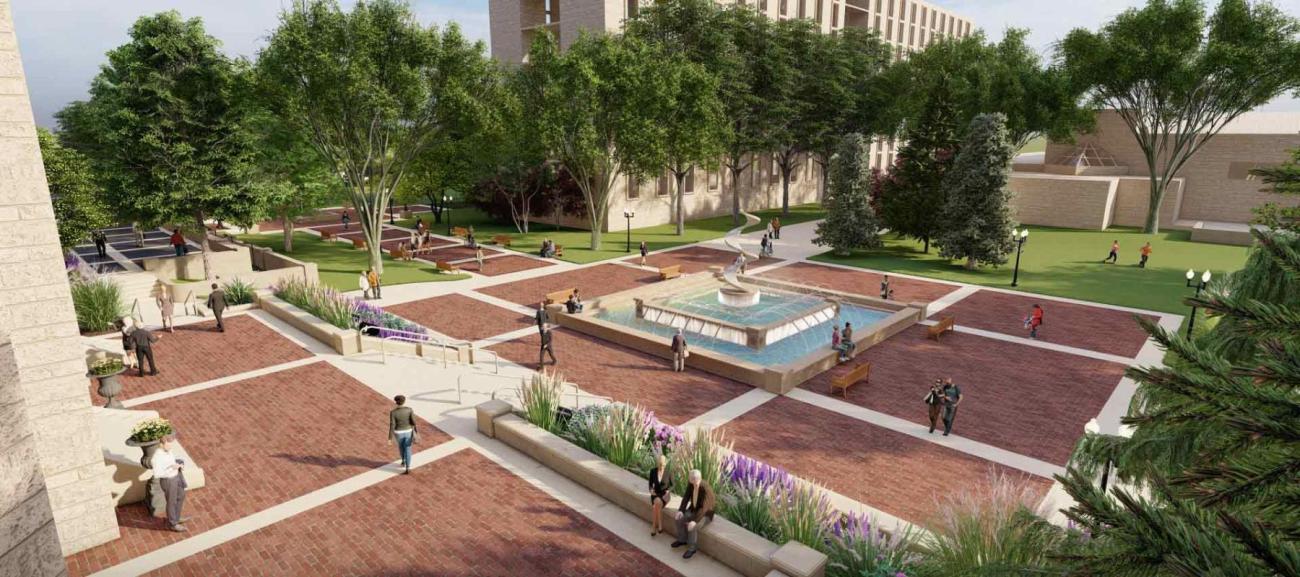
Photo gallery: Images of the St. John's Fountain and Eternal Flame over the years
To scroll through the gallery on desktop, hover over the right or left side of the gallery with your mouse, and arrows will appear. You can also use the arrows on your keyboard.
* * *
A speech about fountains from 1914
"Class of 1914, in the name of the President and faculty of Creighton College, I accept your handsome gift and tender to you our deep appreciation. While we value your gift, we value far more the fine spirit which prompted your giving.
“That spirit is indicative of the loyalty and gratitude in your hearts for the blessing of the education which you have received from your Alma Mater. There is, too, an appropriateness in your gift, for we interpret it as an effort on your part to symbolize the relation your alma mater has held toward you during the years you have been under her tutelage.
“A fountain of pure and living water! A fountain is a perennial source of bountiful giving. It gathers its waters from the muddy rivers of the earth, clarifies them, and pours them out in crystal streams for the benefit of all who will partake. It gives and gives perpetually of its bounty, never asking aught in return of those who take from it, save, the grateful heart of him who came thirsty and went away refreshed.
“A symbol this all is of your college; a fountain she has been to your soul, a fountain of life-giving waters of truth and virtue. From the turbulent streams of life, where error and truth, passion and virtue are strangely commingled, she has drawn out only the purest and the most wholesome, a crystal stream of the untainted truth that nourishes and has offered it to your thirsting souls. Bountifully has she poured it out for all and never asked aught in return save a grateful memory.
“There is an appropriateness in your gift for we further interpret it as a symbol of your gratitude, of a living, lasting gratitude. Of all inanimate things none seems to live like a fountain. It has a. voice and a ceaseless stir. How it compelled the poets to endow it with life. There it will stand, this fountain of yours, for years and years to come, stirring with your spirit, speaking with your voice, speaking gratitude and loyalty, living and lasting. Class of 1914, we thank you.”
